The Barbed Wire Fence Marked an End to What Texas Era?
Barbed wire is one of the most of import inventions of mod times.
I discovered this by blow. It struck me while watching television set how oftentimes barbed wire appeared in news reports about crisis zones. You couldn't escape it: there information technology was, in every war and every demonstration. Wherever migrants or suspected terrorists surfaced, they were held behind barbed wire.
When I decided to examine the history of barbed wire in more detail, I found out that'south how it's been since the get-go. Barbed wire has always been used to separate living beings, commencement animals and later people. It'south what tamed the Wild W. It then entered the world stage with a grisly role in Globe War I. It came to symbolize totalitarianism, thanks to Adolf Hitler and Joseph Stalin. And today, it serves every bit an instrument of economical apartheid, past separating human beings into those who may enter and those stuck exterior.
For
Barbed wire's humble ancestry
Barbed wire could merely have been invented in the U.s.. Nowhere else was the demand for a cheap fencing material and then immense and compelling. The migration of settlers to the W stagnated in the mid-nineteenth century. The main reason for this was as petty as information technology was fundamental: many aspiring farmers were not willing to try their luck as long as they had no idea how they could fence off their land to protect their crops.
All the natural aids that farmers had traditionally used for fencing, such as stones and wood, were lacking on the prairies of the Midwest. Without fencing, the fruit of their labors was under constant threat. Any passing herd of cattle or buffalo could but bruise the growing grain or gobble information technology up.
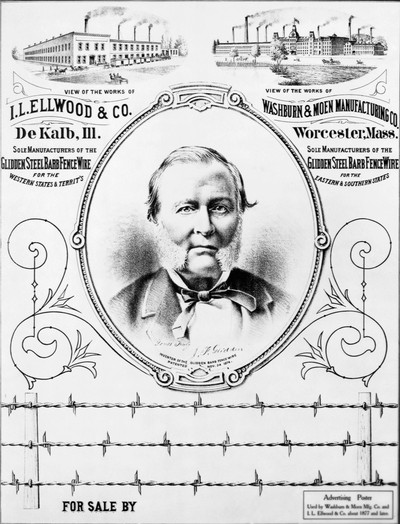
From 1870 to 1878, newspapers and magazines in the Midwest devoted more attention to the thorny topic of fencing than whatever other political, economic, or social upshot. That's revealing. The American Civil War had just ended, and the country was engulfed in a major financial crisis. Simply all that was irrelevant to those yearning for affordable fencing. For these farmers, the invention of barbed wire was like manna from sky. By 1873, people had been hoping and praying for just such a miracle for some time.
"Joe, these cows in my garden are driving me crazy. They're eating all the flowers. Could you delight practise something about information technology?" Lucinda's cry for help is in all likelihood where this story began. "Of grade, Lucy my love, I'll deal with information technology." How this miracle came about is a story that spiritual father Joseph Glidden and his wife Lucinda would recount to journalists afterward. Glidden was a farmer from DeKalb, a small-scale town with a thousand inhabitants in the Mississippi Valley threescore miles west of Chicago.
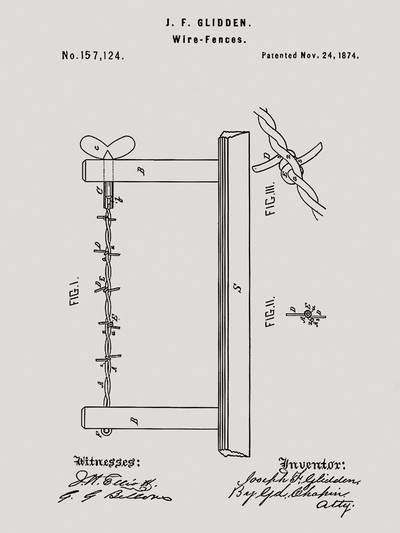
He bought a reel of fence wire at the local hardware shop. And every bit the days began to get shorter, he could be establish working in the kitchen in the evenings. His just tools were a pair of pliers, a set of pincers, and different kinds of hammers.
That fall, Lucinda'due south wire hairpins started to disappear. One evening, Lucinda was surprised to see her husband fish 2 of her hairpins out of his shirt pocket. "What are you doing with my hairpins?" she asked. "I'm working on an idea for a contend," he is said to have answered.
With a pair of pliers he twisted the hairpins one by one into spirals with sharp points. Plain he later used a coffee grinder to make barbs out of wire. He would then attach strands of barbs onto the wire.
There was one annoyance: the barbs wouldn't stay in place. Glidden eventually managed to spike the barbs securely by twisting a 2nd wire around the outset. While he wasn't the get-go to develop barbed fencing, it was this double-wire discovery of Glidden's that made him go down in history as the inventor of spinous wire.
Barbed wire's sweeping impact
The product was a cash moo-cow from twenty-four hour period one. It seemed inconceivable, ten years after it was invented, that the United States had always managed without it. Information technology was lite and cheap, and like shooting fish in a barrel to install and maintain. The need was and then overwhelming, and the business grew so explosively, that in 1884 the weekly newspaper The Prairie Farmer devoted a special effect to the phenomenon that "has no equal in the history of industry."
Barbed wire was the net of the late-nineteenth century. Everyone had to accept it, and accept it now.
"Few names are every bit widely known equally that of Joseph F. Glidden," The Prairie Farmer reported. "Not only has he established a mammoth manufacture, he has also radically changed the global economy. Thanks to his ingenuity and persistence, fencing has become a piece of cake on this rural continent: simple and affordable. He didn't accomplish this on his ain. Merely he did lay the foundations."
With the forcefulness of a tornado, barbed wire cleared the mode for the final stages of settling the Westward. Settlers rushed it in its wake. "More than white settlers moved farther westward in the eight years subsequently affordable textile for fencing was introduced than in the 50 years prior to that," noted the Texan historian Roy D. Holt. At the end of the nineteenth century, 17 1000000 people lived in the Due west. That was 25 times more than than just 60 years before.
Fencing off the wide-open spaces of the American W may accept been inevitable, it initially met with bang-up resistance. Spinous wire provided farmers and some cattle ranchers with unprecedented opportunities. Just at the same time, it threatened the very livelihood of others, including Plains Indian tribes and pocket-size-calibration ranchers, who had never had to ain state to raise livestock. In some states – Texas in particular – this resistance led to bitter Fence-Cutting Wars.
But equally controversial equally the Devil's Rope was, by 1900 the open range was largely a affair of the past, and the cowboy on his way to condign a tall tale. Barbed wire fencing had prevailed.
And barbed wire prevailed wherever information technology was introduced. Barbed wire was the net of the late-nineteenth century. Everyone had to have it, and have it now. Within a quarter of a century, information technology had found its mode to other continents, to all the other areas that needed fencing in order to develop. It reached the Pampas of Argentine republic, the veldts of South Africa, and the steppes of Australia.
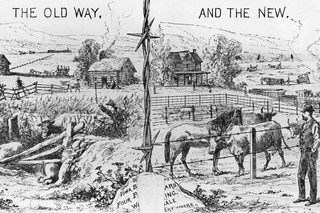
Photo by Hollandse Hoogte
Military utilize
Army commanders discovered the benefits of barbed wire too. You could use information technology to hold upwards an advancing enemy. You could imprison a hostile population on a slice of land with it. That happened on a big scale for the first time during the Second Boer War (1899-1902), the struggle between the British colonial ability and two poor Boer republics in southern Africa, the Orange Free State and the Transvaal Republic. When those immature nations began to appoint in guerilla warfare, the British army restricted the Boer commandos' freedom of movement by edifice a barbed-wire fence more than iii,500 miles long. And Boer women and children were imprisoned in concentration camps in Transvaal surrounded by barbed wire.
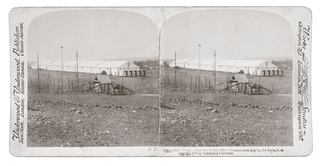
A Mud Hall Prison, where British Officer Prisoners were kept, Southward Africa, 1900. Photo by Getty Images
During World War I, a barbed-wire fence cutting off Belgium from the Netherlands for three years. Belgium was occupied by the Germans, while the Netherlands was neutral. The Germans wanted to prevent, at all costs, Belgian volunteer soldiers from joining the allied troops via holland. They even charged the 206-mile-long fence with electricity. From August 1915 onwards, an electric screen separated the two neighboring countries, from the town of Vaals, near Aachen, Federal republic of germany, all the way to the sea on the western coast. Edge residents called it the dodendraad, or "wire of death."
Ane of the victims was 25-year-old Henricus Lenders from Turnhout, a boondocks most thirty miles east of Antwerp. "The thread of my life," read his in memoriam card, "has been severed faster than a weaver can weave. My days have gone up in fume like a thunderbolt. Beloved wife and dearest children, it was for you that I toiled, and it was my love for y'all that made me fear no danger. In the darkness of night I ready off to foreign parts, never for y'all to come across me once more."
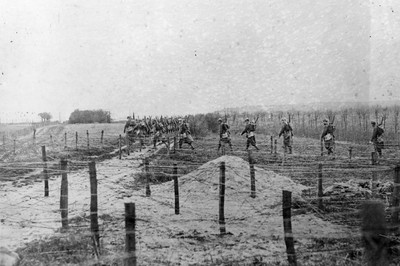
Soldiers make their way across a series of barbed wire defenses in WWI, c. 1915. Photo past Getty Images
How many died along the border is difficult to ascertain. Belgian geography professor Dominique Vanneste, who conducted all-encompassing archival research, estimates 800 casualties. Of the dead whose full names are known, three quarters died by electrocution, one fifth during exchanges of burn, while the cause of death is unknown for the remaining casualties. The total number of victims in three years is estimated to be approximately 2000. Past comparison, in 28 years 136 people died along the Berlin Wall.
Only spinous wire actually took off during Globe State of war I, when trenches, barbed-wire barriers, and machine guns created bulletproof frontlines. It's the only major state of war where barbed wire played a leading part from outset to end. Without barbed wire, the war never would accept dragged on then long. Without barbed wire, the war would never have claimed so many lives.
These are the opening lines of the verse form "Naked Warriors" by British poet Herbert Read:
A man of mine
lies on the wire.
It is death to fetch his soulless corpse.
A man of mine
lies on the wire.
And he volition rot
Even so, barbed wire only became the symbol of totalitarianism and human atrocity in World War Two, as a result of its widespread use in a "monstrous web of slave camps," as Italian writer Primo Levi described the Nazi organization. The eight extermination camps still obscure the fact that there were 42,000 other camps: labor camps, prisoner of state of war camps and concentration camps. They all had one affair in common: barbed wire.
Spinous wire today
It was also spinous wire that divided Europe into capitalist Western Europe and socialist Eastern Europe for near half a century. An Iron Curtain was draped over the continent, from Norway in the N to Turkey in the South. As late as the summertime of 1989, futurity chancellor Gerhard Schröder proclaimed: "Ane should non lie to the new generation after 40 years of West Germany near the chance for German unification: information technology does not exist."
When the Berlin Wall savage in 1989, it briefly seemed like barbed wire'southward triumphant march would come to a halt. Weren't walls and fences and all those other barriers cool and outmoded in a globalizing globe?
But since the terrorist attacks of 9/11, barbed wire has launched another offensive. It shines menacingly on border fences and edge walls that serve to separate wealthy countries from poorer neighbors. It adorns gated communities where the well-to-do barricade themselves in countries where inequality is greatest. Information technology meets a growing need for security in a world of chaos.
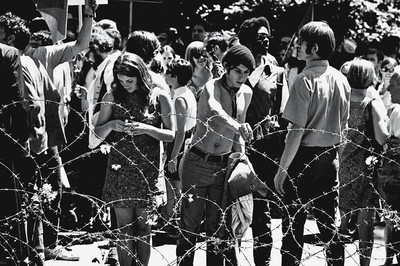
Demonstrators place flowers on a spinous wire fence in People's Park on the campus of the University of Berkeley, 1969. Photo by David Fenton/Getty Images
If Google Globe could wait back in time, to 1874, the yr that spinous wire was invented, and and so visualize the spread of modern types of fencing, not but barbed-wire fences, but also newer versions, such every bit wire mesh and other increasingly clever fences, what would we see?
We would be shocked at how quickly barbed wire managed to fill up large patches of the map in a quarter of a century. And that was just the beginning. Shortly barbed wire and other types of fencing reached the cities. Government used them to split functions: to set off schools from neighborhoods, public gardens from streets. Businesses and citizens protected their valuable possessions behind them.
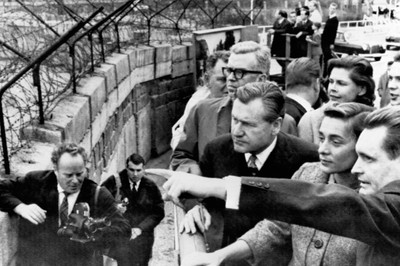
Nelson Rockefeller and his wife view sights on the east side of the Berlin Wall as pointed out past a W German guide. Photo by Hollandse Hoogte
Since 1870 the earth population has quintupled to more than vii billion people. The number of people that live in cities has increased from x% to more than fifty%. The purchasing power of the average world citizen has increased by a factor of 36. The unbridled growth of fencing was a side event. Wherever you looked, barbed wire was thriving.
If Google Globe were to evidence all of this fencing, and then we would see a globe of labyrinths. Never before has and so much of the earth been closed off. Never before has such a big portion of the globe been so compartmentalized.
Today, People's republic of china and India dominate the global barbed-wire market – good for an estimated 500,000 tons of the stuff a year. That's some 5 million miles of barbed wire, enough to circle the earth 200 times. That places however be in our globe where in that location's no barbed wire is zero short of a miracle.
English language translation by Mark Speer and Erica Moore
 Barbed Wire, a History of Good and Evil This brief history of barbed wire is office of my book on the Devil'southward Rope, published in the autumn of 2015 (in Dutch merely).
Barbed Wire, a History of Good and Evil This brief history of barbed wire is office of my book on the Devil'southward Rope, published in the autumn of 2015 (in Dutch merely). 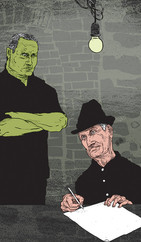 Recollect land grabbing is a thing of the past? Think again More than than a year agone, Luke Dale-Harris stumbled upon a mystery: Romanaian farmers discovered their land had been sold without their cognition or consent. Together with investigative announcer Sorin Semeniuc, he followed the coin trail all the manner to Rabobank, a Dutch banking giant that turns out to take invested millions in agronomical land in the land. How did Rabobank come to own stolen farmland?
Recollect land grabbing is a thing of the past? Think again More than than a year agone, Luke Dale-Harris stumbled upon a mystery: Romanaian farmers discovered their land had been sold without their cognition or consent. Together with investigative announcer Sorin Semeniuc, he followed the coin trail all the manner to Rabobank, a Dutch banking giant that turns out to take invested millions in agronomical land in the land. How did Rabobank come to own stolen farmland? 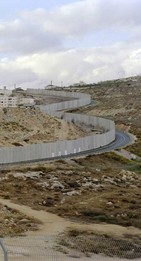 The Return of the Wall Never earlier have we congenital equally many walls along national borders as in the past 15 years. Official reason? The threat of terrorism. But in exercise, walls serve to proceed out ordinary people looking for a better life. I tried to uncover the reasoning behind the trend of the 21st century: constructing border walls.
The Return of the Wall Never earlier have we congenital equally many walls along national borders as in the past 15 years. Official reason? The threat of terrorism. But in exercise, walls serve to proceed out ordinary people looking for a better life. I tried to uncover the reasoning behind the trend of the 21st century: constructing border walls.
Source: https://thecorrespondent.com/3924/never-before-was-so-much-of-the-world-fenced-off-by-barbed-wire/261487512-67a88489
Post a Comment for "The Barbed Wire Fence Marked an End to What Texas Era?"